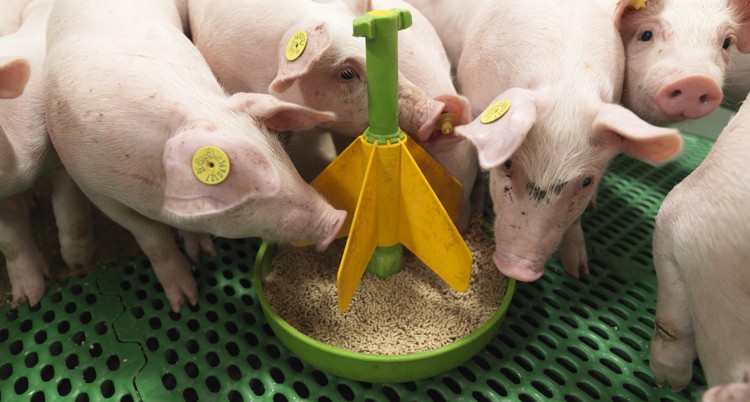Understanding the weaner
(As published in PORCUS - Sept 2016) The weaning period and related stresses have a direct impact on grower herd performance, resulting in reduced profitability. However, by improving management and applying more attention to detail, we may reduce post-weaning losses and improve growth rates by limiting the stress of weaning period. A shorter suckling period will require more sophisticated housing, feeding and management skills to raise the piglet.

Weaning is most commonly done by:
- 21 Days of age (3 weeks)
- 28 Days of age (4 weeks)
- Specialised weaning: segregated early weaning (SEW) and medicated early weaning (MEW)
Conventional weaning (3 - 4 weeks): 5 – 10 kg live weight
At about 28 days of age it is accepted that piglets are of a size and age to fend for themselves under average farming conditions. We must also caution ourselves that the age of weaning forms an integral part of the breeding programme and by reducing weaning age it will change the mating and farrowing programmes. Milk production of the sow falls dramatically 5 weeks into lactation, and changes the economics to non-profitable to continue feeding the piglets via the sow’s milk beyond this stage.
Additional feeding is required to maintain optimal piglet growth rates. At this point in time, piglets should be adapted to dry feed and should be able to adjust better to temperature changes and stress, as they should have had ample exposure in the form of creep feeding under the Sow. However, a high standard of preparation and hygiene must still be maintained. Weaning facilities should be prepared in a way as if the piglets were already there. Pre-heating the house to a suitable temperature, ensuring the feeders have some feed in the pan to ensure the piglets will find the feed easily. Adding free-standing water aids in the process of adjusting to the new environment and has a positive effect on feed intake. The first 2 -3 days after weaning are crucial in order to ensure minimal growth checks. Where a suitable environment is maintained and producers have the expertise, they can progressively reduce the amount of stress during the weaning period.
Weaning early: 4 – 5 kg live weight
At 2 – 3 weeks of age, piglets have reached a stage where their digestive system is more accustomed to handle the more complex carbohydrates in the solid diet. By this age the piglet’s heat regulatory system is also beginning to function more efficiently, enabling it to adjust to reasonable surroundings. During the period 21 – 28 days, it is not uncommon to have piglets scour due to the various immunological and physiological changes which may occur. The degree of the scouring will depend on the organism, level of hygiene, nutrition and the producer’s stockmanship. The use of specialised weaner facilities has contributed considerably to the success of early weaning. As mentioned before, the younger the age at weaning the more attention has to be paid in providing a facility for the piglets that offers them a better chance of success and in return, maximising profitability.
Specialised weaning
- Segregated early weaning
This is weaning pigs at an ‘early’ age, usually less than 18 days old and removing them from the breeding herd immediately after weaning as a means of eliminating, or at least reducing, the disease load in pigs entering weaner facilities. This is a highly sophisticated process and not recommended unless deemed absolutely necessary.
- Medicated early weaning
This technique is used to obtain pigs free from some of the pathogens endemic in the herd. Sows are dosed with high levels of antibiotics when they enter the farrowing house until their piglets are weaned. The piglets are weaned at 5 days of age and moved to an isolated early-weaning unit. This is a specialised facility and one can almost think of it as a neonatal ICU for piglets. Piglets are dosed from birth until about 10 days of age, with similar drugs to those given to the sows. Again, this is highly specialised and not recommended unless deemed necessary.
Complications associated with weaning
Problems can take on various forms:
- the development of stressful behaviours, e.g. cannibalism
- bad toilet habits
- depressed growth rates
- scouring
- compromised immune system
- low feed and water intake
A critical factor is the amount of creep feed consumed prior to weaning. Apart from familiarising piglets to dry feed, feeding creep diets accelerates the maturity, and integrity of the digestive system of the piglet.
The new environment
Piglets establish their dominance or ‘pecking order’ shortly after birth. When weaning time comes, piglets are often placed into a less than ideal environment. Litters are often regrouped according to size and sex and moved to new and strange surroundings where they spend the next few days establishing a new ‘pecking order’ and adjusting to the new environment. This has the effect of reducing crucial feed and water intake, and imposing nutritional stress on the piglet at a very fragile stage in its development. The most important thing the piglet needs to establish is where to find water and food. There are a number of methods or ways to try and help the piglets to finding these crucial essentials and reduce some stress.
Food source
At weaning the piglet has to adjust to a solid diet as opposed to the milk provided by the sow. Even if the piglets were consuming creep feed, they no longer have a free choice between creep feed and milk and their digestive enzymes may take several days to adjust. Hence the importance of providing a creep diet under the sow, to encourage dry feed intake and limit post wean drop. This imposes an initial burden on the digestive system, and its effect will depend on the quality of the feed and the environment provided for the weaners. If pre-weaning feed consumption is low and post-weaning feed management is poor, there is the risk of an antigenic reaction to the feed.
The gut and enzymes
The piglet’s digestive system is set to handle a milk-based diet as its first source of feed. As the piglet matures so does its enzyme system. Therefore, piglets weaned at 28 days of age are more capable of handling non-milk carbohydrates and protein than piglets weaned at, say, 14 days of age. The earlier the piglets are weaned the more the alternative feed should mimic the composition of sow’s milk. The 20% solids in sow’s milk is made up roughly of 8% fat, 6% protein, 5% lactose, 1% minerals and other components, and is completely digestible.
Acknowledging this, diets for the early weaned piglet (10 to16 days) has the most success when they contain significant quantities (30 to 40%) of milk solids (skim milk, whole milk, buttermilk, whey powder and/or lactose), and digestible fat sources. Alternative energy sources such as starch and sugars can also be used but the key is to have them in a readily digestible form and within the ability of the piglet’s enzyme’s to successfully make use of the nutrients.
Stomach pH
The degree of acidity varies along the digestive tract. The pH of the stomach tends to be very acidic (generally pH 2 – 3). This low pH is due to HCL acid secretion which is necessary for the function of protein-digesting enzymes, but more importantly as far as the young piglet is concerned it prevents the excessive multiplication of ingested bacteria.
At feeding, the pH rises towards the pH of the food as the acid in the stomach is diluted, the stomach secretes HCL acid and the pH again falls to a pH of 2 – 3. When the feed is eaten in large quantities at infrequent intervals (which is often the case at weaning), the stomach pH tends to remain higher for longer periods. This allows the bacteria to rapidly multiply and pass on through the stomach to the intestines. This in turn leads to an elevated level of bacteria, and if undigested protein is available, E. coli can thrive and cause various complications such as scouring, oedema and elevated post weaning mortality. The average piglet should eat 18 to 22 meals per day. That is smaller meals more often.
Immunological system
Piglets are born with no protective immunity and rely on the colostrum for the transfer of passive immunity from the sow. Passive immunity lasts for 10–14 days, but the piglet’s own immune system does not really start to develop until 21–28 days of age. We can therefore accept that piglets weaned at 14–28 days are at high risk because their ability to resist a disease challenge is at its lowest. Fortunately, there are effective vaccines and vaccination programmes available for pre- and post-weaning. Discuss their use with your veterinary practitioner.
Identifying “at-risk” pigs: While taking a walk-through of the weaner pool, look at:
- mental status - alert versus excited/depressed
- body condition - fat or normal vs thin
- abdominal shape - bloated or gaunt
- skin - sleek versus fuzzy/woolly
- appetite - feeding at the feeder versus huddled
- evidence of urination and/or defecation
- signs of dehydration - sunken eyes/dry nose
Closing
In short, weaning is the most stressful period in the life of a potential baconer. It has little immunity, after having been taken away from the sow and litter mates, batched according to size and sex in a new strange environment, and needs to find food and water as well as to adjust to the new environment. All this needs to happen in the first 2 - 3 days after weaning to minimise growth checks. Proper preparation prevents poor performance. Take the time and care to prepare the weaning pen to welcome the new arrivals. Make it as comfortable for them as best you can, and in turn maximise profitability. Have a skilled, dedicated person to oversee the weaners and spend time when walking through the weaner pool. Do not manage by exception but rather pay attention to the smallest detail.
References: Graeme Taylor and Greg Roese, Livestock Officers Pigs, Intensive Industries Development, Tamworth - This Primefact is one of five articles providing an overview of basic pig husbandry, covering boars, gilts and sows, the litter, weaners and grower herds. / The Pig Site / SAPPO Article Archive
